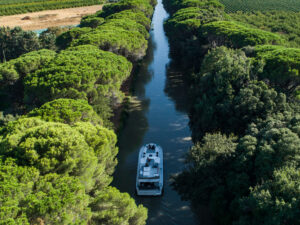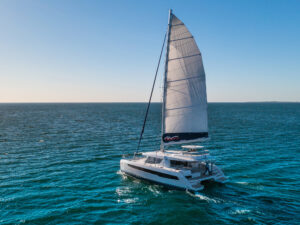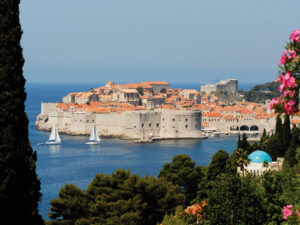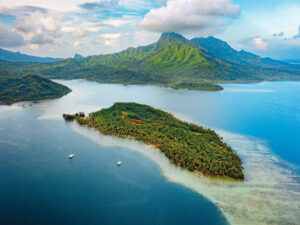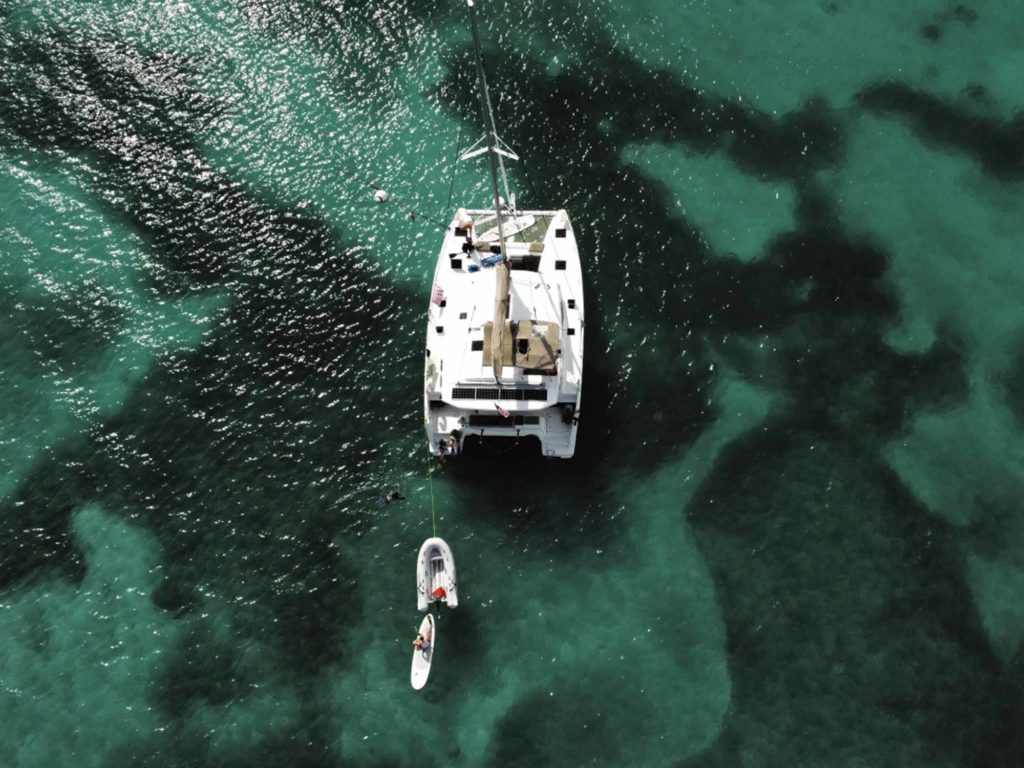
Uno!”
The now-familiar game-ending shout rang out from the cockpit, followed by the groan of the other players and the gloating of the victorious. I heard the cards reshuffle and another round begin. We were underway during a weeklong charter of the Florida Keys, and I was patting myself on the back for remembering to grab a few games and decks of cards before we left the dock. With sketchy cell service in the area, the kids—three teens and one preteen—had a sort-of forced break from their screens and made heavy use of the games, Uno in particular. To me, this was nothing short of magic, during a year that desperately needed some.
The idea of a shared charter between our family (myself; my husband, Green; and our daughters, Caitlin, 15, and Juliana, 11) and our close friends Giulia and William May (and their daughters, Marianna, 17, and Camilla, 15) came up a couple of years prior, but we were finally all able to make it happen in December 2020.
With travel restrictions and rising COVID-19 numbers pretty much everywhere this past winter, we needed a destination that would be easy to get to (our family was driving) and, well, open. Dream Yacht Charter’s new base in Key West, Florida, was a perfect fit, and a sort of return to some old stomping grounds.
Dream Yacht Charter opened its Key West base at the Stock Island Yacht Club & Marina in fall 2020. Domestic charter destinations received a huge boost due to COVID-related international travel restrictions, and Key West and the Florida Keys are about as tropical as you can get without leaving the continental US. To our crew, this sounded absolutely perfect.
Green and I grew up in Florida and lived for a while pre-kids on our boat in Key West. We haven’t been back often since, and this was the first time we’ve taken the girls there. They humored us, more or less, on our memory-lane trip down the Overseas Highway. Our friends beat us there, and we met up with William and Marianna at the marina pool waiting for our charter boat to be ready for us. Not wanting to waste a minute of time, Giulia and Camilla were already on a massive provisioning run.
“Should we have a teen side and an adult side? Or should each family get a hull?” These were the totally legitimate questions being floated by the kids as we climbed aboard and shared a welcome toast with our glasses of champagne. Our ride for the week was a Fountaine Pajot Astréa 42 named Asgard, and with four en suite cabins, it was a perfect fit. While each rooming plan had its merits, we ended up with a hull for each family, although Juliana typically slept in the main saloon. The well-appointed galley was Giulia’s domain (Italian through and through, she’s honestly one of the best cooks I know), and stowing the bounty she brought back from the store took some finesse. One thing was for sure: No one would starve this week.
On our first night away from the dock, we didn’t go all that far. Last-minute trips to stores for random forgotten items and another bottle or so of rum—just in case—took up a chunk of the morning, but once we pulled away, it felt great. We anchored off Archer Key, one of the small mangrove islands about 5 miles west of Key West, but it instantly felt a world away. The girls took no time at all getting in the water, while Green and William went exploring in the dinghy. Giulia and I enjoyed some prosecco while watching one of the Keys’ famous sunsets. The weight of 2020 that everyone had been carrying in some way evaporated, even if it was only for the week.
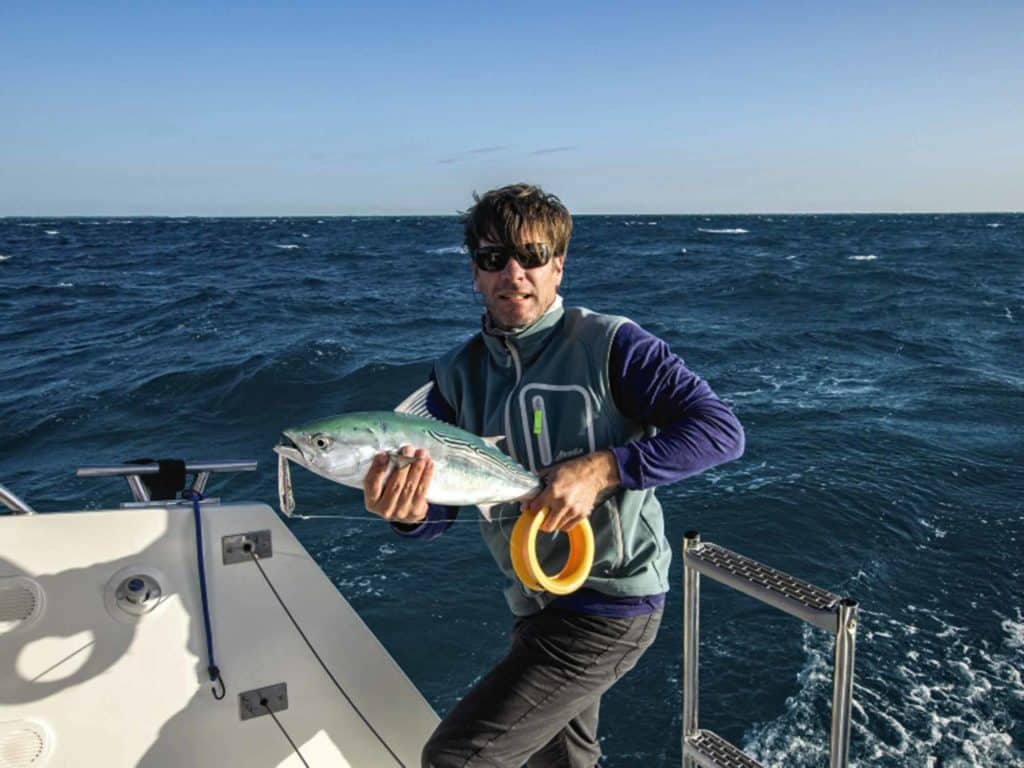
From the planning stages of this trip, the goal had always been to visit the Dry Tortugas. Even though I used to live in the Keys, I had never been, and the photos of Fort Jefferson looked so intriguing (It’s a big brick fort! In the middle of the water!) that we were all really excited to see it. Honestly, we thought it would be a given. Realistically, however, the Dry Tortugas is about 70 miles west of Key West. A haul, and depending on the weather, it could be lovely, or a complete no-go. And there’s the return trip to think about as well.
The distances involved and the time we had in which to do it all was definitely in the back of my mind. Green’s too, particularly when he checked the latest weather forecast. For the most part, December is a wonderful time to be in Key West, but cold fronts do come through and can mess up an otherwise well-planned week. Of course, one was coming, and we needed a more protected anchorage to sit it out. Our Day Two destination became Newfound Harbor, up the Keys a bit, between Ramrod Key and Little Torch Key. A conservative move, but we were on vacation and didn’t want an uncomfortable night at anchor. And fortunately, we left our first anchorage early enough to give us time for a stop at the reef.
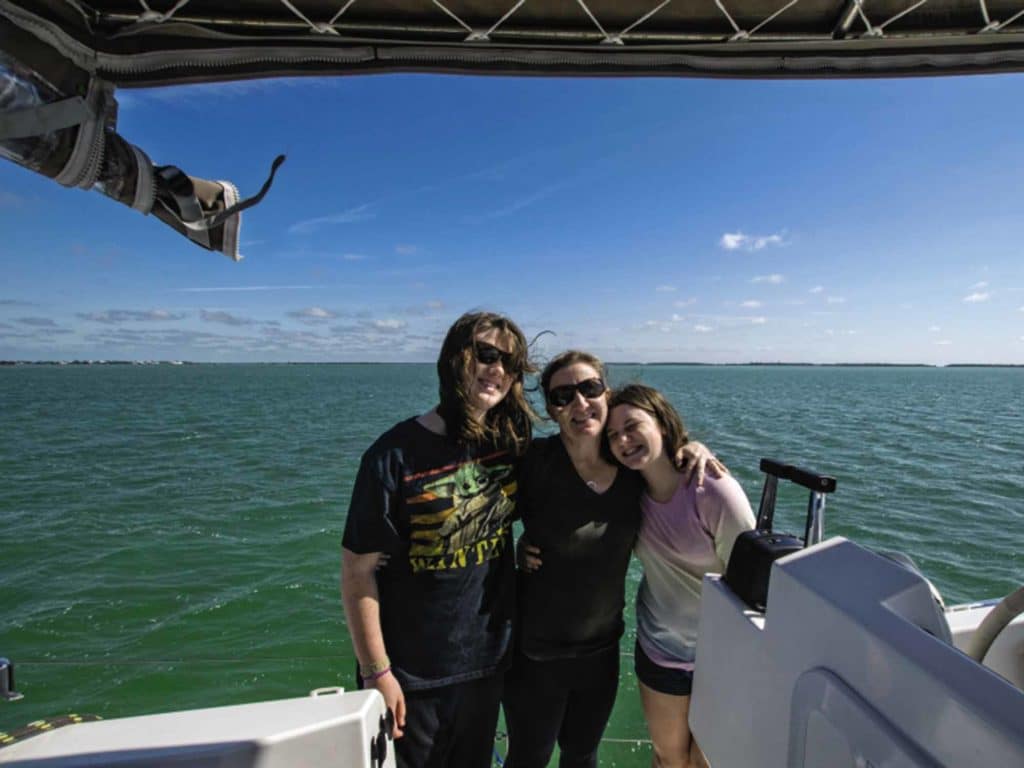
The Keys are protected by the Florida Reef, the third-largest coral barrier-reef system in the world. It extends nearly 350 miles from St. Lucie to the Dry Tortugas and in depths ranging from 15 to 35 feet. A highlight of any trip to the Keys includes diving or snorkeling at any one of the reef sites. The Florida Keys National Marine Sanctuary maintains almost 500 free moorings along the reef for visiting mariners on a first-come, first-served basis, and we were able to grab one not too far from Key West for our snorkel adventure.
“The fish are nibbling my toes!” Camilla squealed as she swam in the turquoise water of the Sand Key reef, southwest of Key West. The rest of us geared up with our snorkel stuff and jumped in. The fish, used to plenty of day-trippers from the snorkel boats, were indeed friendly. At 30 feet or so, the reef is very accessible to snorkelers and divers alike. The water felt refreshing, and there was even a turtle sighting. Back aboard, it was time for lunch and a drink before heading to our anchorage ahead of the front. William, an eager fisherman, got the lines ready to troll behind the boat for the roughly 25-mile trip. The Keys is a world-class fishing destination, and visions of mahimahi whet everyone’s appetites.
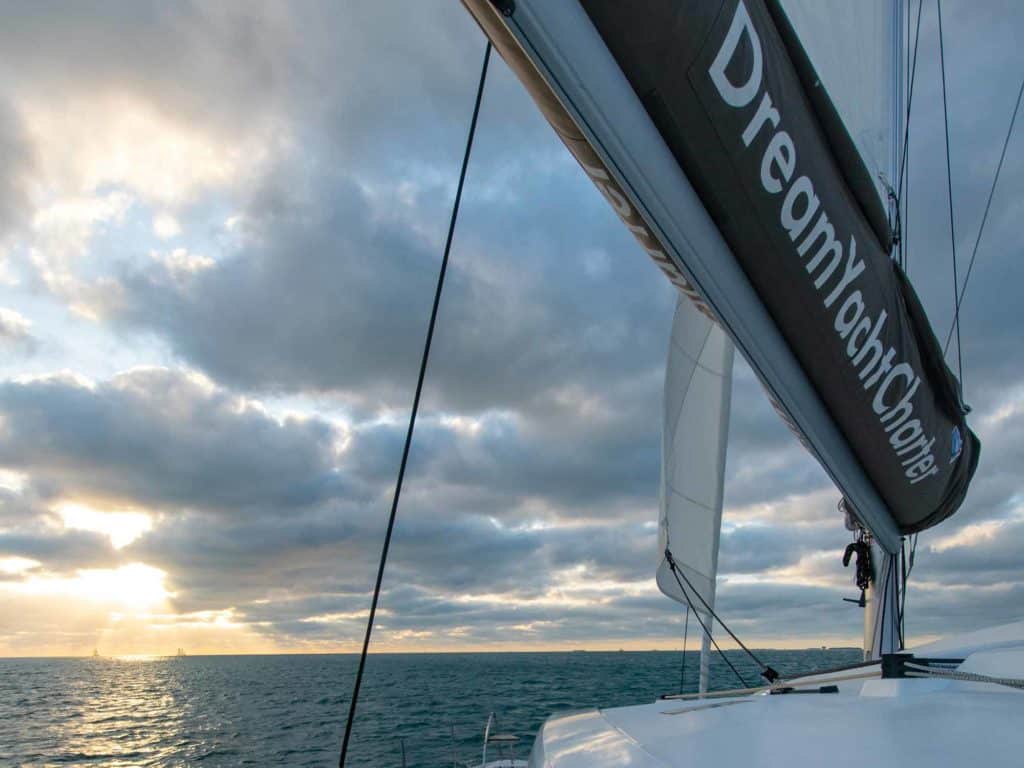
To try for the Dry Tortugas—or not. Green called a crew meeting to discuss our plan. Depending on how strong the front was, and how sloppy the seas were, the trip to the Dry Tortugas could be, well, uncomfortable, and several of our crew tend to get seasick. If conditions weren’t right, we could run out of time waiting for an appropriate window to make it there and back. If this were the case, he said, we should come up with a plan B. The thought of not going to the Dry Tortugas and checking out Fort Jefferson was disappointing, to be sure, but the thought of anyone being miserable was bad too. So we sketched out an alternative: Sail up the Keys and check out all the dive spots, have a beach day at Bahia Honda State Park, and maybe spend time in Key West at the end, with lots of sailing, relaxing, good food and Uno games to pass the time. No stress. Not a bad plan, really.
The front came though that evening, and our protected anchorage did its job of keeping everyone comfortable. Swimming at the reef plus a good sail meant that we slept well. The next morning, the sun was shining and the crew was eager to get underway. But where to? We took another look at the weather and decided that, as long as everyone was on board, so to speak, we could make a go of the Dry Tortugas. The plan now was to head back down to Key West, splurge on a slip at Key West Bight Marina, and then, assuming the weather was still favorable, be off the dock by 0700 the next morning.
With the post-frontal wind now a bit northerly, we had a nice, if chilly, reach back to Key West. None of the kids had been there before, so we decided to check out downtown. Due to peaking COVID numbers pretty much everywhere in December 2020, we all decided to play it as safe as we could, and skipped the many bars and restaurants dotting Duval Street. Not to worry—Key West is crazy enough, even if you’re just out for a stroll. The Cuban music, Christmas lights, and even a bike parade with dozens of people dressed in Santa’s finery all added to the town’s festive feel. We hit a few obligatory souvenir shops, and once the kids started asking to stop at the henna tattoo booth, we decided it was time to head back to the boat. Dinner was burgers on the grill, and Giulia introduced us to a version of a mojito cocktail that replaces the soda water with lager-style beer. And dare I say, it was pretty good.
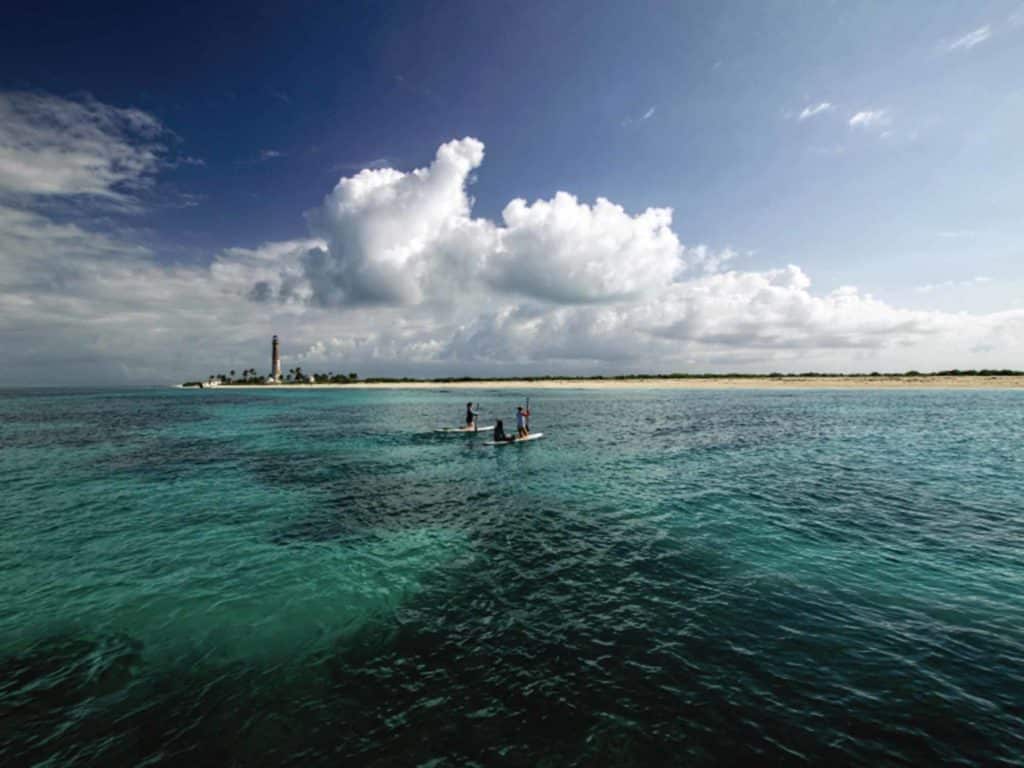
The sun wasn’t quite up as Green, William and Marianna got the boat ready to head out while I settled up the dockage bill and bought some ice for the cooler. The weather report looked good—our sail there would likely be bumpy, but our return trip in two days should be smooth sailing. It was definitely sweatshirt weather, but at least the sky was clear. We motored out of the marina, and once in open water, put up the sails. Next stop: Dry Tortugas National Park!
Our ETA was about 1530, and conditions were a bit sporty. Much of the run between Key West and the Dry Tortugas is in relatively shallow water, which can kick up waves. Juliana—who, despite growing up on a sailboat, still has a tough time at sea—slept most of the day. Caitlin and Marianna took turns at the helm for a while, while William remained hopeful that his fishing lines would produce a tasty dinner. After a while, the kids retreated to the saloon for some rounds of Uno while glancing at their phones as the cell signal faded away.
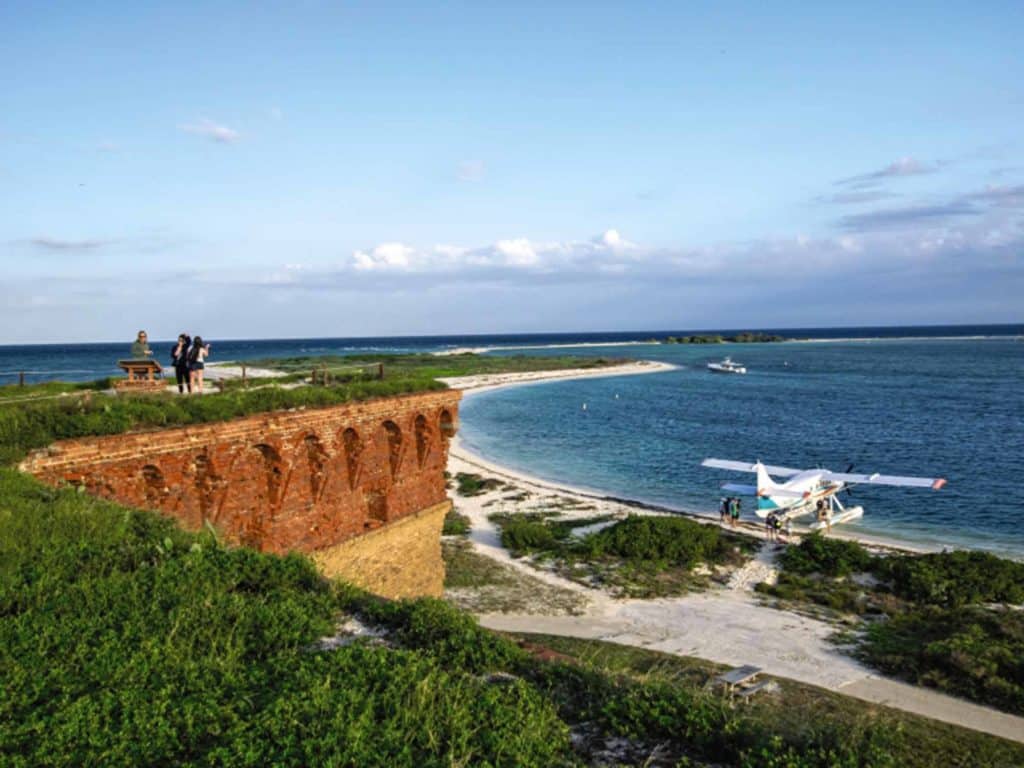
The Dry Tortugas might be only 70 miles away, but it really feels out there. Not often on a charter vacation do you have the opportunity to sail out of sight of land, so this journey really felt like an adventure. There are a number of shoals (some are marked) and wrecks of various depths on the chart, so a keen watch was necessary. Asgard handled herself well, and I found myself really appreciating the ergonomics of the boat—everywhere I sat was comfortable, and handholds were always in just the right places. It occurred to me on this leg of the trip why I hadn’t actually ever been to these islands before, despite having lived on a boat in Key West. Green and I had lived aboard a 32-foot Pearson Vanguard at the time, and unless the winds and seas were perfect, it would have been a long slog of a trip. The timing just never had been right.
“Fish on!” William shouted, and from the trouble he was having reeling in the line, we all thought it could be a big one. With fingers crossed for a mahi, he instead landed a false albacore/bonito. False albacore can be a tricky fish to prepare, and since none of us had had success with it before, we tossed it back. Ah well… there were more fish in the sea, right?
I had taken a break from the sun and had been reading in my cabin for a little bit, and when I came back up, Green directed me to the horizon. Rising out of the bright cerulean water was a brick-red fort. It seemed so out of place, like it had been magically placed there. We had finally made it to Fort Jefferson and Dry Tortugas National Park.
While a seemingly unlikely place for a massive fort, the location of the Dry Tortugas served as a strategic advance post for ships patrolling the Gulf of Mexico and Florida Strait in the mid-1800s. Comprised of more than 16 million bricks, it’s the largest masonry structure in the Western Hemisphere. Pondering the logistics of building it is mind-blowing. Construction of the fort lasted for 30 years, from 1846 to 1875, though it was never actually finished; construction eventually ended with the Civil War, when the fort was used as a Union prison. The most famous (infamous?) prisoner there was Dr. Samuel Mudd, who was convicted of conspiracy in the assassination of President Lincoln and had set the broken leg of John Wilkes Booth, Lincoln’s assassin.
There are extensive reefs surrounding the islands of the park, so to get to the main anchorage on the southeast side of the fort, you need to basically do a wide circle around the island. We happily dropped the hook at about 1530, and decided to immediately go check out the fort. It was nothing short of impressive. We chatted with one of the park rangers stationed there and took a self-guided tour. Since it was late in the day, we nearly had the fort to ourselves. Day-trippers come over by ferry and seaplane, so once they leave, it’s just the campers who are staying at the primitive campground adjacent to the fort, and the cruisers. The late-afternoon light was gorgeous, and we all enjoyed stretching our legs as we walked under the multitude of brick arches and explored each level of the fort.
Back at the boat, the girls brought out the Scrabble board and invented some creative takes on the game. Asgard was pretty tricked out, so after dinner we connected our phones and cameras to the boat’s TV and played slideshows of all the photos we had all taken so far. Choosing a “photo of the day” was difficult. With the Dry Tortugas’ remote location comes a feeling of really getting away from it all, which is amplified when you take a look at the night sky—the stars there are incredible.
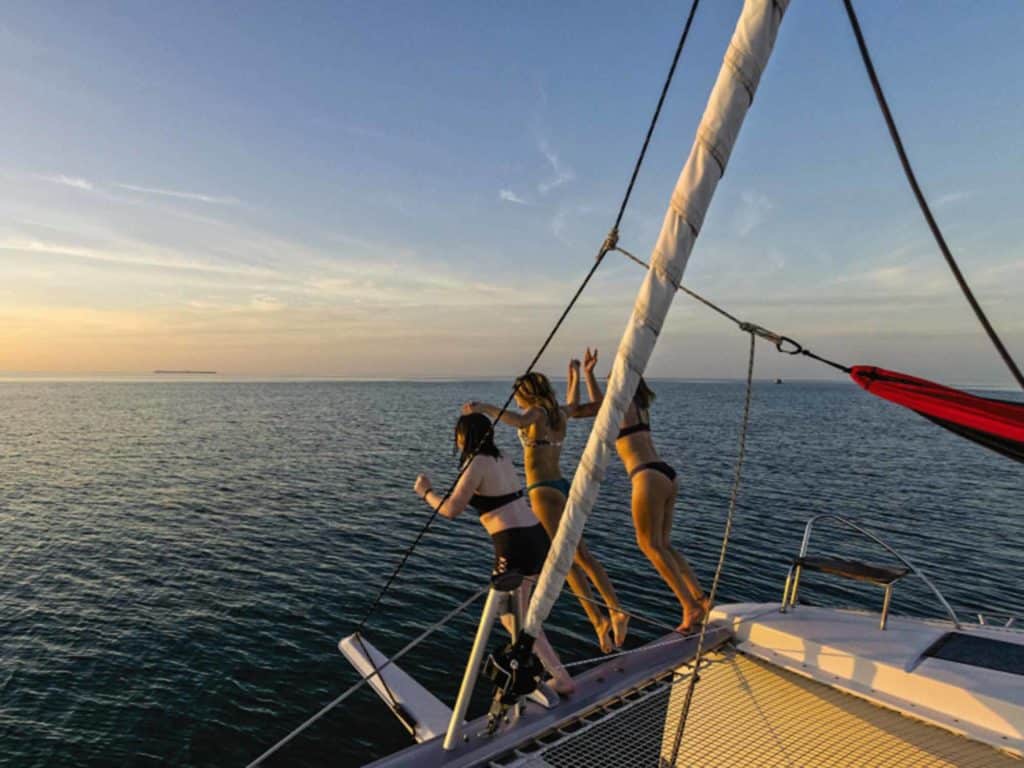
There is more to the Dry Tortugas than Fort Jefferson (which is technically on Garden Key), so the next day, we sailed over to Loggerhead Key, which is notable because of its beautiful lighthouse. Due to the reefs, no sailing between the islands is direct, and our journey to the west side of Loggerhead took most of the morning. There is one day-use mooring buoy here, and we were lucky to snag it. The angle of the sun, however, was less than ideal for getting to the mooring, which is situated among numerous coral heads. After a nail-biting 15 minutes on approach and a few close calls, we were secured and eager to get in the water. I had rented two inflatable stand-up paddleboards from Dream for the week, and we finally got to use them. Everyone had a blast swimming, checking out the coral heads near the boat, and paddling the boards. And the vista couldn’t be beat. “This is easily one of the prettiest places I’ve ever been,” Green commented. I had to agree.
Later that afternoon, we took the dinghy on a snorkel expedition of a shipwreck on the reef extending to the southwest of Loggerhead Key. Much of the wreck is close enough to the surface to be snorkel-friendly, although I would have loved to have had scuba equipment with me. The site, known as the Windjammer Wreck, is a Norwegian sailing vessel named Avanti that sank in 1907 while en route to Uruguay from Pensacola. It might not be easy to impress teenagers, but I’m pretty sure that snorkeling on a shipwreck did.
Unfortunately, our time at Loggerhead was up, and we trekked back to the fort anchorage for the night. We made it back with enough time for Juliana to have one more swim and for William and Camilla to explore in the dinghy along the shore. Sunset that night was breathtaking, and I swear that I saw the green flash. After dinner, William was trying a little night fishing from the stern when something in the water grabbed his attention. It seemed…big. Maybe a shark? Shining his headlamp into the water for a closer look, he discovered who our visitors were: three goliath groupers. He quickly put the fishing gear away, and we all gathered on the transoms to watch the incredible fish, which I had never seen in the wild before. Goliath groupers are an endangered species and can grow to be more than 8 feet long and 800 pounds. Their visit lasted easily a half-hour and was one of the coolest things I’ve witnessed. Watching the kids take it all in was the best part.
All too soon it was time to head back to the Dream Yacht Charter base. Our return sail was as lovely as the sail there was sporty, and everyone was in high spirits from the adventure we’d just had. After a few days of no cell signal, the teens were ready to be connected again, although I definitely was not. We made good enough time for a stop at the Marquesas Keys, an uninhabited group of islands west of Key West. The islands are low and mostly mangroves, and for us, unfortunately, offered no fishing luck. Oh well.
Since the boat had to be back at the base by 0900, we decided to anchor out for our last night aboard near the entrance channel to the marina. On the way there, William did have some fishing success, and a king mackerel would be part of the night’s menu, along with any of the remaining provisions. Taking in one last sunset, we all reflected on what an amazing week it had been. Giulia put it best when she wished out loud that we could just keep going. Me too, I thought, and we started chatting about where we might want to charter next.
We turned in Asgard the next morning and said our goodbyes, thankful for the opportunity, and in particular to have shared it with the kids. Taking a break from the stress of 2020 and piling on a boat for a week truly soothed our souls—even the teens had to agree—and it was, in ways we all needed, magic.
Jennifer Brett is CW’s senior editor.
If You Go
Weather: Key West is a year-round sailing destination, although the best time to go is between early November and early May. Summers are hot and humid with frequent thunderstorms and a chance of tropical storms. Winters can range from warm and muggy to cooler and drier if a front has passed through. While in the Dry Tortugas, you can check with the park rangers for the latest weather forecast (since your cell phone won’t work, and reception of NOAA weather radio is spotty).
Fishing: The waters of the Florida Keys and Dry Tortugas are highly regulated, so it’s best to brush up on the rules ahead of time. If you plan on fishing, purchase your fishing license before your charter at gooutdoorsflorida.com.
Park Fees: Visitors to the Dry Tortugas National Park must pay an entry fee, and if you’re there on a boat, you’ll need a boat permit. All can be purchased at the Garden Key dock house.

